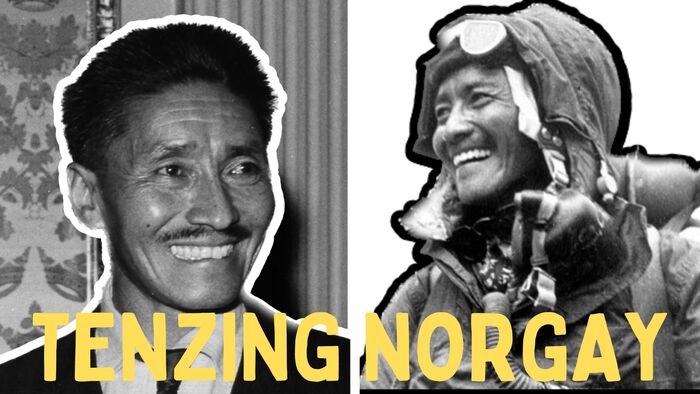Tenzing Norgay GM OSN, originally named Namgyal Wangdi, also referred as Sherpa Tenzing was a renowned Nepali-Indian Sherpa mountaineer born in May 1914. Together with Edmund Hillary, he achieved the remarkable feat of being among the first two individuals to reach the summit of Mount Everest on 29th May 1953. Notably, Time magazine recognized Norgay’s influence by including him in their list of the 100 most influential people of the 20th century.
Tenzing Norgay’s Early Life
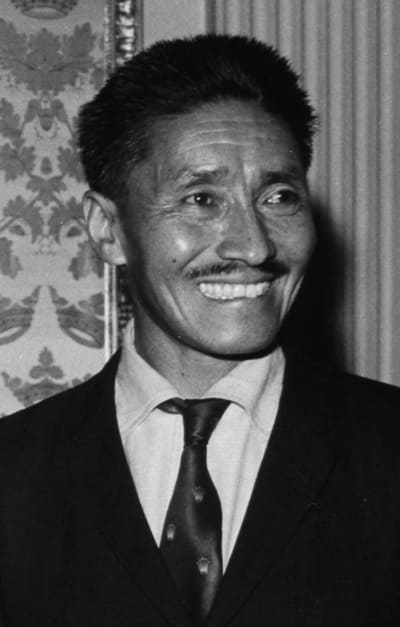
Tenzing’s early life remains a subject of conflicting accounts. According to his autobiography, he claimed to be a Sherpa, born and raised in Tengboche, Khumbu, located in northeastern Nepal. However, in a 1985 interview with All India Radio, he mentioned that his parents hailed from Tibet, while he was born in Nepal.
As per later sources, including a book co-written by his son Jamling Tenzing Norgay, Tenzing was actually born in Tibet, specifically at Tse Chu in the Kama Valley, and grew up in Thame. During his early childhood, he resided in Kharta, situated near the northern region of Tibet. Tenzing’s journey to Nepal occurred when he was just a child, as he went to work for a Sherpa family in Khumbu.
Although the precise date of his birth remains uncertain; after successfully reaching the summit of Everest on 29th May 1953, he chose to commemorate his birthday on that day every year thereafter.
Originally known as “Namgyal Wangdi,” Tenzing’s name was changed during his childhood following the advice of Ngawang Tenzin Norbu, the head lama and founder of Rongbuk Monastery. From then on, he became known as “Tenzing Norgay,” a name that carries the meaning of “wealthy-fortunate-follower-of-religion.” His father, Ghang La Mingma, earned a living as a Tibetan yak herder until his passing in 1949, while his mother, Dokmo Kinzom, also Tibetan, lived long enough to witness his remarkable ascent of Everest. Tenzing was born as the 11th child among 13 siblings, some of whom tragically passed away at a young age.
During his teenage years, Tenzing’s adventurous spirit led him to run away from home twice. First, he made his way to Kathmandu, and later, he ventured to Darjeeling, India, which was then a significant starting point for expeditions in the eastern Himalayas. An attempt was made to send him to Tengboche Monastery to become a monk, but he decided that monastic life was not his calling and chose a different path. At the age of 19, he found his home within the Sherpa community in the Too Song Busti district of Darjeeling.
Tenzing’s Mountaineering Journey
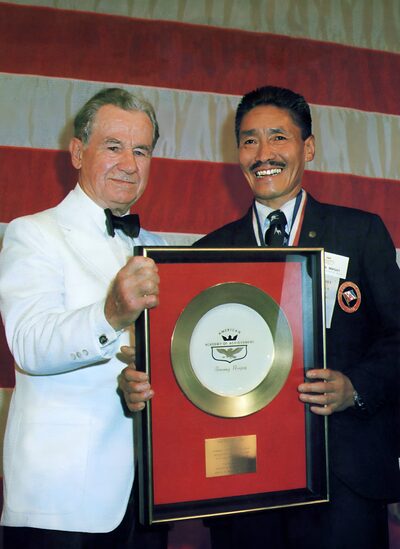
At the young age of 20, Norgay received his initial chance to join an Everest expedition in 1935. This opportunity arose as Eric Shipton was organizing the British Mount Everest reconnaissance expedition for that year. When two other potential team members did not pass their medical examinations, Norgay’s friend, Ang Tharkay, a Sherpa sirdar with previous experience from the 1933 British Mount Everest expedition, advocated for Norgay. It was Norgay’s captivating smile that caught the attention of Shipton, who, impressed by the young man, made the decision to include him in the expedition.
In the 1930s, Norgay actively participated as a high-altitude porter in three official British expeditions aimed at conquering Mount Everest from the northern Tibetan side.
(In the image: During the 1973 Banquet of the Golden Plate ceremonies in Chicago, pioneering newscaster Lowell Thomas, also the Awards Council chairman, proudly presents the Academy’s Golden Plate Award to Sherpa mountaineer Tenzing Norgay. This prestigious recognition comes two decades after Tenzing Norgay and Edmund Hillary achieved the historic milestone of being the first individuals to reach the summit of Mount Everest.)
During the 1936 expedition, he collaborated closely with John Morris, contributing his expertise to the challenging endeavor. In addition to his involvement in Everest attempts, Norgay engaged in numerous other mountaineering expeditions across various regions of the Indian subcontinent.
In the early 1940s, he found himself residing in the princely state of Chitral. There, he served as a batman to Major Chapman. Tragically, Norgay’s first wife passed away during his stay in Chitral, and she was laid to rest in the state. In 1947, Norgay returned to Darjeeling along with his two daughters.
In the 1947, Norgay embarked on a daring but ultimately unsuccessful summit attempt of Everest. Alongside Canadian-born mountaineer Earl Denman and Ang Dawa Sherpa, he ventured into Tibet illicitly to take on the challenging climb. However, their aspirations were struck by a fierce storm at an altitude of 6,700 m. Accepting defeat, Denman made the decision to turn back, and all three climbers safely returned.
In the same year, Norgay assumed the role of a sirdar for the first time in a Swiss expedition. This appointment came after his crucial involvement in the rescue of Sirdar Wangdi Norbu, who had suffered a serious injury from a fall. The Swiss expedition achieved a significant feat by reaching the main summit of Kedarnath, situated at 22,769 feet (6,940 m) in the western Garhwal Himalaya. Norgay was an integral part of the summit party, marking another accomplishment in his illustrious mountaineering career.
The 1952 Swiss Mount Everest expedition
In 1952, Tenzing Norgay played a significant role in two Swiss expeditions, led by Edouard Wyss-Dunant in the spring and Gabriel Chevalley in the autumn. These expeditions marked the first serious attempts to scale Everest from the southern (Nepalese) side, following earlier reconnaissance everest expeditions by the United States and Britain in 1950 and 1951.
During these Swiss endeavors, Tenzing Norgay, along with Raymond Lambert, achieved an impressive altitude of approximately 8,595 meters (28,199 ft) on the southeast ridge, setting a climbing record. This expedition paved the way for a new route on Everest, which would later be successfully conquered the following year. Notably, on 28th May, Norgay and Raymond Lambert reached an even higher point at 8,600 meters (28,215 ft), establishing a new then-record height.
This expedition held particular significance for Norgay, as he was now officially considered a full expedition member, an honor that deeply touched him. The experience fostered a lasting friendship between Norgay and his Swiss companions, especially with Raymond Lambert.
1953: The First Sherpa To Summit Mount Everest
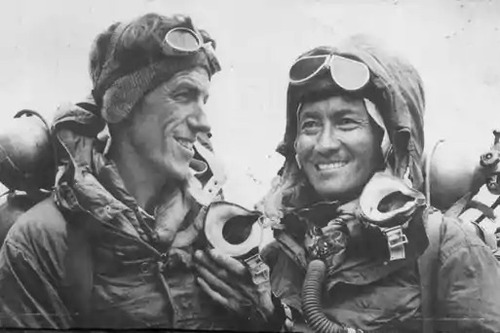
During the 1953 British Mount Everest Expedition, Tenzing Norgay participated in the expedition led by John Hunt, which marked his 7th visit to Everest (while Hunt had been there three times before). Among the team members was Edmund Hillary, who narrowly escaped a serious fall into a crevasse. Norgay’s swift action in securing the rope with his ice axe, helped Hillary avoid a potentially disastrous outcome. This incident left a deep impression on Hillary, who considered Norgay his ideal climbing partner for any future attempt at reaching the summit.
The Hunt expedition comprised a considerable team of over 400 people, including 362 porters, 20 Sherpa guides, and a massive load of 10,000 pounds (4,500 kg) of baggage. Like many expeditions of its kind, it was a collective effort, highlighting the importance of teamwork and cooperation.
In March 1953, the expedition established its base camp. Reflecting on the past, Hillary recounted in 1975 his initial encounter with Norgay in Kathmandu, which occurred on the 5th of March 1953:
I was eager to meet Tenzing Norgay. His reputation had been most impressive even before his two great efforts with the Swiss expedition … Tenzing really looked the part – larger than most Sherpas he was very strong and active; his flashing smile was irresistible; and he was incredibly patient with all our questions and requests. His success in the past had given him great physical confidence – I think that even then he expected to be a member of the final assault party … One message came through however in very positive fashion – Tenzing had substantially greater personal ambition than any Sherpa I had met.
The Historic Ascent: Tenzing Norgay and Edmund Hillary Conquer Everest
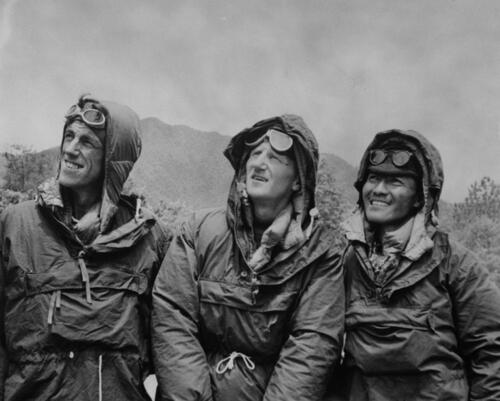
Progressing steadily, the expedition eventually established their second-to-last camp at the South Col, positioned at an altitude of 25,900 feet (7,900 m). On May 26th, Tom Bourdillon and Charles Evans commenced their climb but had to turn back due to Evans’ malfunctioning oxygen system. Despite their setback, they managed to reach the South Summit, coming within 300 vertical feet (91 m) of the true summit. Following this, Hunt made the decision to assign Norgay and Hillary for the final push to the top.
However, snow and wind delayed the pair’s progress at the South Col for two days. On 28th May, accompanied by a support team comprising Ang Nyima, Alfred Gregory, and George Lowe, Norgay and Hillary set out. At 27,900 feet (8,500 m), they pitched their tent, while the supporting group descended the mountain.
The following morning, Hillary faced an obstacle as he discovered his boots frozen solid outside the tent. He dedicated two hours to thawing them before he and Tenzing commenced their final ascent, carrying 30-pound (14 kg) packs. The final part of their climb involved a challenging 40-foot (12 m) rock face, later renowned as the Hillary Step. Hillary found a way to wedge himself upward by utilizing a crack between the rock wall and the ice, and Norgay followed his lead.
Reaching the Summit of Mount Everest
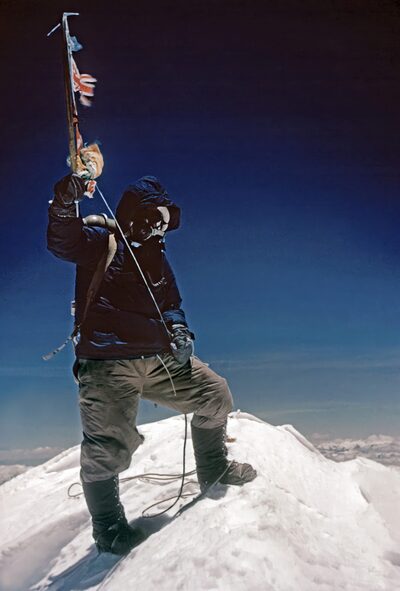
With the summit within reach, the following effort proved relatively straightforward. At 11:30 a.m., they achieved their ultimate goal, standing at the summit of Mount Everest, the highest point on Earth. As described by Hillary, a few more strikes of the ice axe into the solid snow, and their feat was accomplished.
Their time at the summit was brief, lasting only around 15 minutes. During this short stay, Hillary captured the iconic photo of Norgay proudly posing with his ice-axe. Unfortunately, since Norgay was not familiar with operating a camera, Hillary’s own ascent remained undocumented. Nevertheless, according to Norgay’s autobiography “Man of Everest,” he offered to take Hillary’s picture, but the latter declined, gesturing that he did not desire it.
To ensure the authenticity of their achievement, they took additional photos looking down the mountain, confirming their success and documenting the journey to dispel any doubts about the ascent’s legitimacy.
As they began their descent, they encountered drifting snow that had covered their tracks, complicating the process of retracing their steps. However, they managed to come down carefully. Along the way, they were greeted by Lowe, who had climbed up to meet them with a comforting serving of hot soup.
(In the image: Captured by Edmund Hillary, this iconic photograph immortalizes Tenzing Norgay as they reached the summit of Mount Everest. Regarded as the pinnacle of 20th-century athletic triumphs, their ascent remains a celebrated achievement.)
Honors and Controversy: Recognition After Everest Conquest
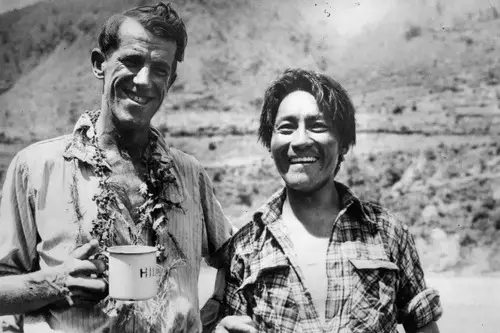
Following their historic achievement, Norgay received a hero’s welcome and was greeted with immense adoration in Nepal and India. For their remarkable feat, Hillary and Hunt were bestowed knighthood by Queen Elizabeth II, honoring their outstanding contributions. Norgay, on the other hand, was recognized for his exceptional efforts on the expedition with the George Medal.
It has been a long road … From a mountain coolie, a bearer of loads, to a wearer of a coat with rows of medals who is carried about in planes and worries about income tax.
— Tenzing Norgay
However, concerns over inequity arose, as reported by National Geographic,
Hillary was knighted for his achievement as the first confirmed person to reach the summit of Mount Everest. Yet, Tenzing, who also stood atop the summit simultaneously, was only granted an honorary medal. Over the years, this discrepancy has sparked increasing discontent and calls for proper official recognition.
— National Geographic
The Truth of Everest’s Summit: Norgay and Hillary as a Unified Team
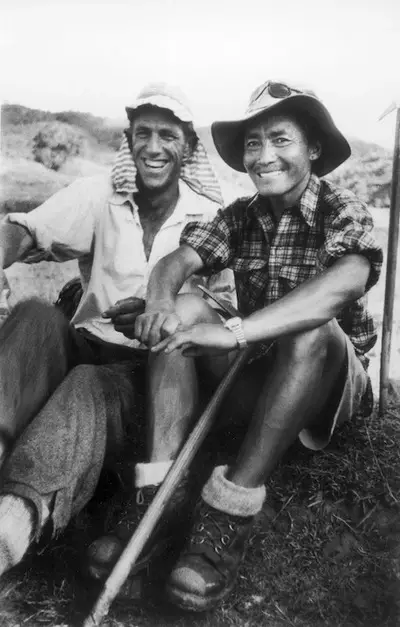
Norgay and Hillary achieved the groundbreaking feat of being the first confirmed individuals to reach the summit of Mount Everest. However, journalists persistently questioned the distinction between the two, pondering who deserved the glory of being deemed the “first” and who was simply the “second” or follower. In response to the ongoing debate, Colonel Hunt, the leader of the expedition, emphasized that they had reached the summit together as a cohesive team.
Ultimately, Norgay himself put an end to the speculation by revealing the truth in his 1955 autobiography, which was ghost-written by American author James Ramsay Ullman – as Norgay could converse fluently in various languages but lacked the ability to read or write. He disclosed that Hillary had stepped on the summit first, while they were roped together with a six-foot distance between them.
During their ascent, just below the summit, they paused, not dwelling on the notions of “first” or “second.” Norgay firmly denied any thoughts of competing for a supposed “golden apple” at the summit, expressing no desire to push Hillary aside for personal gain. Instead, they proceeded slowly and steadily, and finally, together, they reached the coveted peak.
(In the image: Edmund Hillary and Tenzing Norgay sitting together after the pair became first to scale Mount Everest. James Burke—The LIFE Picture Collection/Getty Images)
Tenzing Norgay: Life After Everest
In 1954, Tenzing Norgay became the first Director of Field Training at the Himalayan Mountaineering Institute in Darjeeling. In January 1975, with the gracious approval of Bhutan’s King Jigme Singye Wangchuck, Norgay served as the sirdar (guide) for an American tourist party, making them the first group of American tourists allowed into the country.
Organized by a company then known as Mountain Travel (now Mountain Travel-Sobek), the group had the opportunity to meet Norgay in India before commencing their trek. The official journey began in Paro, northern Bhutan, encompassing a visit to the revered Tiger’s Nest (Paro Taktsang), an ancient Buddhist monastery. The expedition then continued through Nepal and Sikkim, concluding in India.
Throughout the adventure, Norgay introduced his group to the King of Sikkim, the last monarch of Sikkim as it is now a part of India. Additionally, he welcomed them into his own home in India, where they shared a heartfelt farewell celebration.
In 1978, Tenzing Norgay established Tenzing Norgay Adventures, a company specializing in organizing trekking adventures across the majestic Himalayas. As of 2021, the company has been successfully overseen by his son, Jamling Tenzing Norgay, who himself accomplished the remarkable feat of reaching the summit of Everest in 1996.
Honors and Recognitions: Celebrating Tenzing Norgay’s Extraordinary Achievements
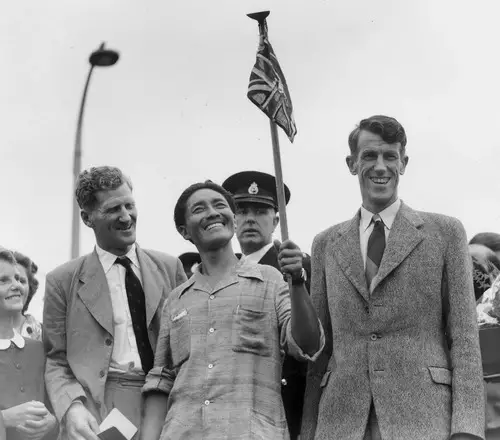
In 1938, after Norgay’s third Everest expedition serving as a porter, the Himalayan Club recognized his exceptional high-altitude work and awarded him its prestigious Tiger Medal.
On 7 June 1953, a momentous announcement revealed that Queen Elizabeth II sought to honor Norgay’s remarkable achievements. Subsequently, on 1st July, 10 Downing Street disclosed that after consulting with the governments of India and Nepal, the Queen had approved the awarding of the George Medal to Norgay. Additionally, he, along with the entire Everest party, received the Queen Elizabeth II Coronation Medal. In May 2013, Tenzing Norgay’s grandson, Tashi Tenzing, expressed his belief that his grandfather deserved knighthood, not merely a medal.
Throughout the years, Norgay received several accolades for his extraordinary feats. In 1953, King Tribhuvan of Nepal bestowed upon him the distinguished Order of the Star of Nepal, 1st Class (Supradipta-Manyabara-Nepal-Tara). The Government of India recognized his achievements in 1959 by awarding him the prestigious Padma Bhushan, the country’s third-highest civilian award. The Indian Mountaineering Foundation also honored him with its coveted gold medal.
In a historic moment, on 1 March 1963, the Soviet Union granted Norgay the honorary title of “Merited Master of Sport of the USSR,” making him the first foreigner to be bestowed with this esteemed distinction.
To immortalize his legacy, in September 2013, the Government of Nepal proposed the name “Tenzing Peak” in his honor for a magnificent mountain that stands tall at 7,916 meters (25,971 ft) in Nepal. Tenzing Peak lies along the long Ridge from Cho Oyu to Gyuchung Kang, with Tenzing Peak being closer to Cho Oyu. Additionally, in July 2015, the highest-known mountain range on the dwarf planet Pluto, soaring 3.4 kilometers (11,000 ft) high, was named “Tenzing Montes” as a tribute to his extraordinary achievements.
Tenzing Norgay: Family and Death
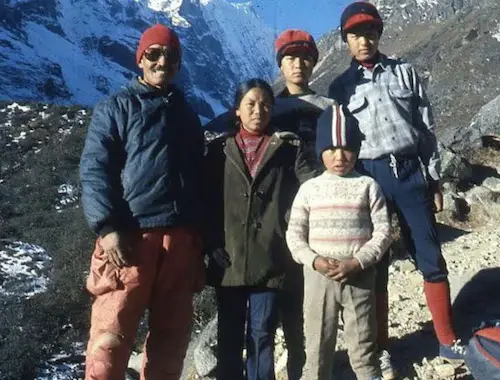
Norgay experienced three marriages in his lifetime. His first wife, Dawa Phuti, tragically passed away at a young age in 1944. His second wife, Ang Lahmu, happened to be a cousin of his late first wife. While they did not have biological children together, she lovingly assumed the role of adoptive mother to Norgay’s daughters from his previous marriage with her cousin.
Subsequently, Norgay married Dakku as per Sherpa custom, even while his second wife was still alive. Dakku became Norgay’s third wife, and together, they had three sons (Norbu, Jamling, and Dhamey) and one daughter, Deki, who later married American lawyer Clark Trainor. In 2003, Norgay’s son Jamling would embark on an iconic expedition, climbing Everest alongside Peter Hillary, the son of Edmund Hillary, commemorating the 50th anniversary of their fathers’ historic ascent.
Norgay’s life came to an end on the 9th of May 1986, in Darjeeling, West Bengal, India, when he suffered a cerebral hemorrhage at the age of 71. His remains were cremated in his cherished place, the Himalayan Mountaineering Institute in Darjeeling, a location he deeply cherished. His widow, Dakku, passed away in 1992.
Achievements and Legacy of Tenzing Norgay
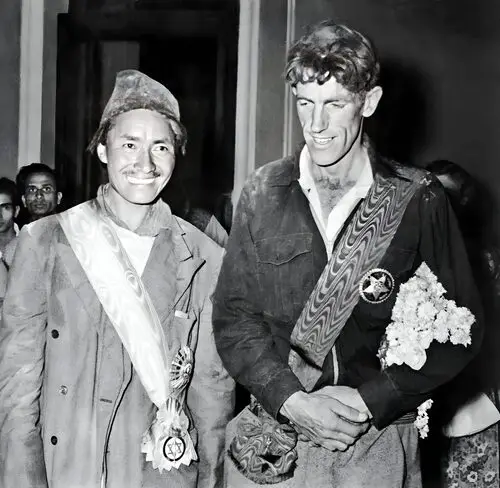
As one of the first people to reach the summit of Mount Everest, Norgay’s mountaineering prowess left an indelible mark on history. Beyond his remarkable ascent, his life was filled with numerous achievements:
- In 2003, to honor the 50th anniversary of Norgay’s historic Everest summit, the Indian government bestowed a meaningful tribute by renaming its most esteemed adventure sports award. Henceforth, the highest accolade in adventure sports in India would bear the illustrious name of the “Tenzing Norgay National Adventure Award” in recognition of his indelible contribution to the world of mountaineering and exploration.
- In 2011, Amar Chitra Katha, an Indian comic publisher, released a children’s comic book dedicated to the inspiring life of Tenzing Norgay.
- In the 2003 American film “Intolerable Cruelty,” created by the Coen brothers, Norgay is mentioned as a metaphor for the positive act of enabling, adding depth to the film’s main character.
- In Kent, England, one of the buildings at Everest Court, Mottingham, bears the esteemed name of Tenzing Norgay, commemorating his legendary achievements.
- In a fitting tribute to their monumental feat, Lukla Airport in Nepal was renamed Tenzing–Hillary Airport in January 2008, immortalizing the pair’s historic accomplishment.
- Tenzing Montes, an icy mountain range on the surface of Pluto, symbolically acknowledges Norgay’s extraordinary journey by carrying his name among the celestial heights.
- A minor planet was named 6481 Tenzing, a celestial body eternally symbolizing the spirit of adventure and exploration that defined his life.
- The renowned energy drink brand, TENZING, proudly bears the name in honor of the legendary mountaineer Tenzing Norgay, a tribute to his exceptional achievements and enduring legacy.
